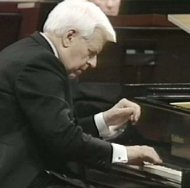70904 for PDF 11/05 - Ivory Classics
70904 for PDF 11/05 - Ivory Classics
70904 for PDF 11/05 - Ivory Classics
Create successful ePaper yourself
Turn your PDF publications into a flip-book with our unique Google optimized e-Paper software.
Tchaikovsky composed only two works he labeled “Sonata” and both were <strong>for</strong> solo piano.<br />
The first, in c-sharp minor, Opus 80, was one of his earliest works of any kind, composed in<br />
1865. Tchaikovsky considered this Sonata a student work and withheld it from publication.<br />
The rather late opus number was affixed at the time of the posthumous publication in 1900.<br />
Tchaikovsky’s second sonata was begun on March 13, 1878, a few days be<strong>for</strong>e he started work<br />
on his celebrated Violin Concerto. Tchaikovsky completed it on August 7th of that year and<br />
it was premiered in Moscow by Nikolai Rubinstein on November 2, 1879.<br />
The “Grand Sonata” (at it is sometimes known) is in G Major and in four movements.<br />
The work is unusually rich in musical ideas. The first movement is built up of measured<br />
march rhythms and impassioned recitatives, giving the impression of a greatly augmented<br />
introduction confined within the sonata framework. The march movement in 3/4 changes to<br />
a recitative theme. Elements of improvisation and drama merge in the solemn phrases of<br />
musical oratory. A passionate restless second theme is contrasted to the calm serenity of the<br />
concluding part. The solemn development is crowned by a tense march in 3/4. The same<br />
march motif predominates in the brilliant coda. The second movement, marked Andante, is<br />
extremely poetic. Its main theme, touched by a sorrowful lyricism, is set off by a number of<br />
whimsical episodes and is somewhat reminiscent of Schumann. The light, un<strong>for</strong>ced Scherzo<br />
might well belong to a Schumann Novellette. The finale, however, is dominated, like the first<br />
movement, by the composer’s preoccupation with constructing a large-scale, elaborate discourse.<br />
The Sonata in G Major, Opus 37 closes on an orchestrally majestic tone.<br />
<strong>11</strong> Chopin: Polonaise Fantaisie in A-flat Major, Op.61 and<br />
13 Chopin: Waltz in A-flat Major, Op.42<br />
Frederic Chopin arrived almost immediately at a personal idiom that is absolutely unmistakable<br />
– an original style so pervasive that a fragmentary bar or two will serve to identify a<br />
composition as his. With a rarer sense of what kingdom he could make his own, he chose to<br />
write music <strong>for</strong> the piano. He never composed an opera or an oratorio, a symphony nor even<br />
a string quartet. These large <strong>for</strong>ms he left to others. He worked in a dozen or more <strong>for</strong>ms, several<br />
of them his own creation. Chopin has left us mazurkas, fresh and narrative; waltzes, prismatic<br />
from his alembic imagination; nocturnes, the perfection of chivalrous dreams; scherzos,<br />
tragic to the heart’s core; preludes, Wordsworthian in simplicity and charm; etudes, complete<br />
as sonnets; impromptus, full of life or touched with tenderest romance; polonaises, the<br />
exquisite expression of the pageantry of his native land; and three sonatas, each a tremen-<br />
– 7 –














